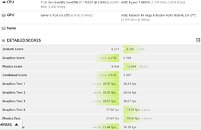- Joined
- Oct 9, 2007
- Messages
- 47,670 (7.43/day)
- Location
- Dublin, Ireland
| System Name | RBMK-1000 |
|---|---|
| Processor | AMD Ryzen 7 5700G |
| Motherboard | Gigabyte B550 AORUS Elite V2 |
| Cooling | DeepCool Gammax L240 V2 |
| Memory | 2x 16GB DDR4-3200 |
| Video Card(s) | Galax RTX 4070 Ti EX |
| Storage | Samsung 990 1TB |
| Display(s) | BenQ 1440p 60 Hz 27-inch |
| Case | Corsair Carbide 100R |
| Audio Device(s) | ASUS SupremeFX S1220A |
| Power Supply | Cooler Master MWE Gold 650W |
| Mouse | ASUS ROG Strix Impact |
| Keyboard | Gamdias Hermes E2 |
| Software | Windows 11 Pro |
Intel's 11th generation Core i7-1165G7 "Tiger Lake-U" processor armed with 4 "Willow Cove" cores and Gen12 Xe graphics fights a pitched battle against AMD Ryzen 7 4800U "Renoir" (8 "Zen 2" cores and Radeon Vega 8 graphics), courtesy of some digging by Thai PC enthusiast TUM_APISAK. The 4800U beats the i7-1165G7 by a wafer-thin margin of 1.9% despite double the CPU core-count and a supposedly advanced iGPU, with 6331 points as against 6211 points of the Intel chip, in 3DMark 11. A breakdown of the score reveals fascinating details of the battle.
The Core i7-1165G7 beats the Ryzen 7 4800U in graphics tests, with a graphics score of 6218 points, against 6104 points of the 4800U, resulting in a 1.9% lead. In graphics tests 1, 2, and 3, the Gen12 Xe iGPU is 7.3-8.9% faster than the Radeon Vega 8, through translating to 2-4 FPS. The Intel iGPU crosses the 30 FPS mark in these three tests. With graphics test 4, the AMD iGPU ends up 8.8% faster. Much of AMD's performance gains come from its massive 55.6% physics score lead thanks to its 8-core/16-thread CPU, which ends up beating the 4-core/8-thread "Willow Cove," with the 4800U scoring 12494 points compared to 8028 points for the i7-1165G7. This CPU muscle also plays a big role in graphics test 4. This battle provides sufficient basis to speculate that "Tiger Lake-U" will have a very uphill task matching "Renoir-U" chips such as the Ryzen 7 4800U, and the upcoming Ryzen 9 4900U (designed to compete with the i7-1185G7).

View at TechPowerUp Main Site
The Core i7-1165G7 beats the Ryzen 7 4800U in graphics tests, with a graphics score of 6218 points, against 6104 points of the 4800U, resulting in a 1.9% lead. In graphics tests 1, 2, and 3, the Gen12 Xe iGPU is 7.3-8.9% faster than the Radeon Vega 8, through translating to 2-4 FPS. The Intel iGPU crosses the 30 FPS mark in these three tests. With graphics test 4, the AMD iGPU ends up 8.8% faster. Much of AMD's performance gains come from its massive 55.6% physics score lead thanks to its 8-core/16-thread CPU, which ends up beating the 4-core/8-thread "Willow Cove," with the 4800U scoring 12494 points compared to 8028 points for the i7-1165G7. This CPU muscle also plays a big role in graphics test 4. This battle provides sufficient basis to speculate that "Tiger Lake-U" will have a very uphill task matching "Renoir-U" chips such as the Ryzen 7 4800U, and the upcoming Ryzen 9 4900U (designed to compete with the i7-1185G7).

View at TechPowerUp Main Site






